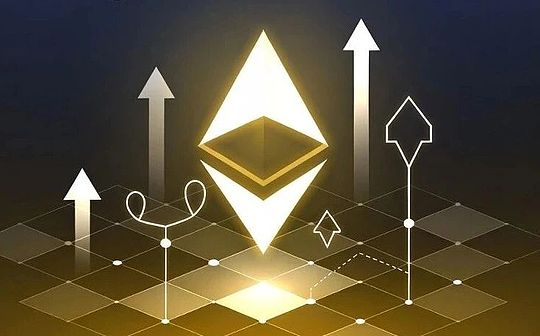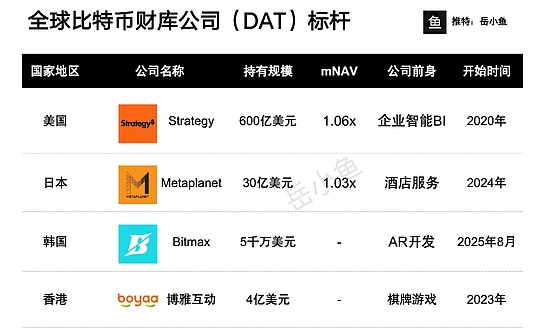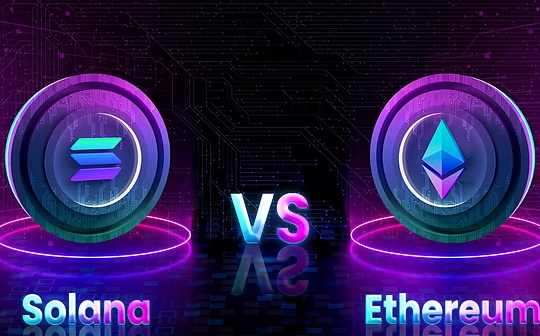
Author: Tanay Ved, Matías Andrade Source: Coin Metrics Translation: Shan Oppa, Bitchain Vision
Key points:
-
Ethereum has a stake of 34.4 million ETH (28% of the current supply), while Solana has an active stake of 297 million SOL (51% of the current supply), because the entry barriers for the principal are low.
-
Ethereum has a larger validator set with 1.07 million validators, while Solana, which has more hardware requirements, has 5,048 validators, but has more than 1.21 million principals.
-
Ethereum’s nominal staking yield is 3.08% (2.73% adjusted for inflation), which is the benchmark for on-chain economy.Solana offers a higher yield of 11.5% (actual yield of 12.5%), but the principal’s return is lower than the validator due to the different reward structures.
-
The continued issuance of Ethereum results in an annualized inflation of 0.35%, while the destruction of EIP-1559 usually leads to a period of deflation.Solana follows an era-based inflation plan with current annualized inflation of 4.7%, and will stabilize at 1.5%.
introduce
Ethereum and Solana are the two largest Proof of Stake (PoS) blockchain networks, each using different approaches to reach consensus and protect their ecosystems.Both rely on staking, requiring participants to submit their native tokens, ETH or SOL, to validators who play a key role in maintaining network integrity.To motivate honest participation, pledgers can obtainPledgeaward, keep their behavior consistent with the best interests of the network.
This yield enhances their attractiveness as cash flow-generating assets, acting as a benchmark interest rate in the on-chain economy, similar to U.S. Treasury bonds in traditional finance.In this week’sNetwork Status in,We studied Coin Metrics’ new staking yields and inflation indicators to understand Ethereum and Solana’s staking mechanisms and network economy and to embody their staking ecosystem.
Overview of Ethereum staking
Since the introduction of the beacon chain (consensus layer) in December 2020, 34.4 million ETH has been pledged on the Ethereum network.28% of ETH’s current supply of 120.4 million are pledged (also known as the pledge rate), while 72% are still unstaked, in smart contracts and externally owned accounts.Although Ethereum’s staking rate has rapidly increased from 14% to 28% after Shapella upgrade, the ratio has remained at around 28% as staking demand has cooled down.
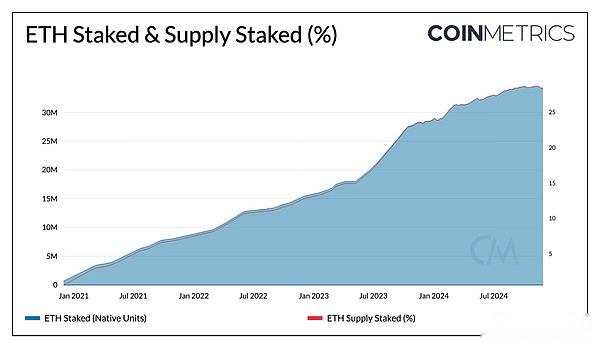
Source: Coin Metrics Network Data Pro
To be a validator on the Ethereum network, participants must contribute 32 ETH as collateral or provide smaller denominations to staking pools or exchanges that manage staking operations.This 32 ETH is also known as the maximum valid balance of the verifier, in the upcomingPectraDuring upgrade, the balance will be changed to up to 2048 ETH.Ethereum currently has 1.07 million active validators, and this number is expected to decline as validator integration progresses.
Ethereum staking yield analysis
Today, ETH’s nominal pledge yield is 3.08%, while the actual (inflation-adjusted) yield is 2.73%.As the amount of staking ETH increases, Ethereum’s basic staking yields decline over time.These rewards come from two main sources, reflecting the modular design of Ethereum:Consensus layer rewardsandExecution layer rewards.
Validators receive consensus layer rewards for their role in protecting the network, including proof and proposing new blocks.These awards are funded through newly issued ETH, helping to network inflation and forming a more predictable source of income.On the other hand, execution layer rewards are related to changes in block space requirements, including priority fees and maximum extractable value (MEV).During periods of increased activity, such as the increase in block space demand in March, actual staking APY soared to 6.2%, and exceeded 5% on August 5, 2024,This is due to higher priority fees, and therefore also includes executive layer rewards.
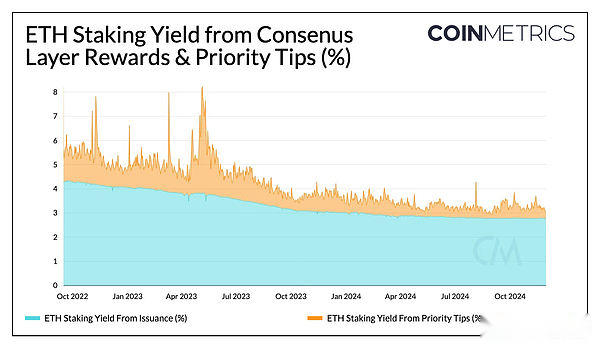
Source: Coin Metrics Network Data Pro
ETH pledge yield as on-chain benchmark interest rate
The pledge yield can be nominallyorActual (adjusted by inflation)to evaluate the returns of participating in the Ethereum consensus process.This helps the staker or investor understand their true rate of return and compare it with holding unsolicited ETH.More broadly, ETH staking yields are the benchmark interest rate for the on-chain economy, similar to the references to U.S. Treasury yields in traditional finance.It provides a way to compare risk-free interest rates and pledge yields, highlighting opportunities in both on-chain and off-chain ecosystems.
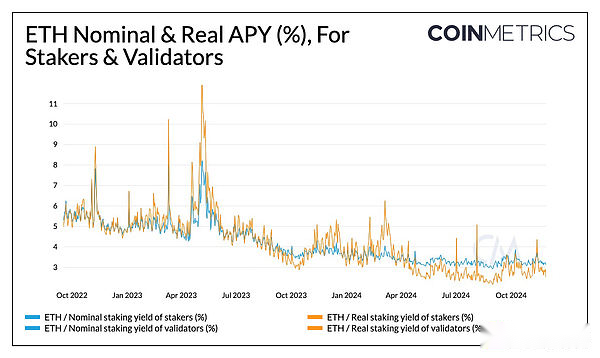
Source: Coin Metrics Network Data Pro
This staking yield could further enhance the attractiveness of ETH in investment vehicles such as ETFs, as relaxed regulation could pave the way for staking-based Ethereum ETFs.ETH staking yields also support several DeFi primitives, such as liquid pledged tokens as collateral for earnings, as well as stablecoins such as USDe of Ethena and re-staking ecosystems such as EigenLayer.

Source: Coin Metrics Network Data Pro
There is a close interaction between Ethereum’s economic design and staking incentives, which are affected by network activity, transaction fees and ETH inflation rates.The more network activity on the mainnet and Layer-2, the higher the transaction fee will be, which will result in more ETH being destroyed through the EIP-1559 mechanism, resulting in a period of deflation.When the destruction exceeds the issuance, inflation-adjusted yields become more attractive.Ethereum’s current daily inflation rate is 0.00096%, and its annualized rate is 0.35%, because the issuance volume is slightly higher than the destruction volume.
Solana staking overview
Solana adopts the “Delegated Proof of Stake” (DPoS) consensus mechanism.This allows the verifier and principal (SOL holders who contribute their interests to the verifier) to pledge SOL.Together, these tokens constitute the “interest” of validators, which determines their influence in the consensus process and their ability to verify blocks.
Unlike Ethereum, Solana does not have a minimum balance requirement for participating in staking.This low threshold makes its pledge rate relatively high, reaching 51%. Of the current supply of 589 million SOLs, 297 million SOLs are actively pledged.Active pledges are calculated based on validators and principals who have received rewards in the most recent period and do not include those who have not received rewards or withdrawn before the end of the period.

Source: Coin Metrics Network Data Pro
Therefore, there are 1.22 million pledges on Solana, of which 1.21 million are principals.However, the number of validators is much smaller, with only 5048.This may be because running Solana validators requires high performance infrastructure and a large amount of SOL staking.The network adopts a leader-based consensus process where a single validator is assigned to process blocks based on a rotation schedule.Leadership is determined by the pledge weight, ensuring that verifiers with more pledges have greater influence.
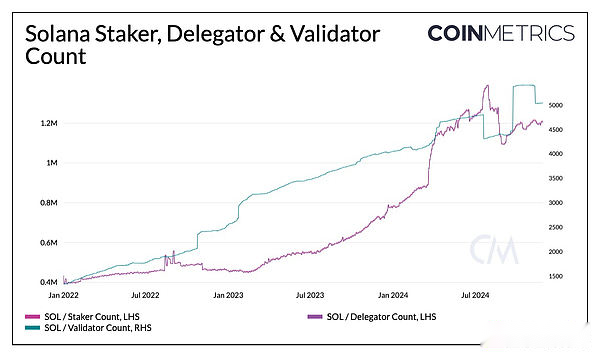
Source: Coin Metrics Network Data Pro
Solana Inflation and Pledge Yield Dynamics
Solana uses inflation models to allocate staking rewards, and SOL is issued once per period (about 2-3 days).This has led to “fluctuations” in the new issuance in the figure below.Inflation begins in 2021 at 8%, with an estimated annual decline of 15% and is currently 4.7%.
The pledge proceeds mainly come from inflationary rewards allocated under this plan, supplemented by 50% base fees, all priority fees and MEV.It is also worth noting that 92% of stakes on Solana use the Jito Verifier client, which provides additional off-protocol economic incentives for the Verifier via tips.While Solana has also seen liquidity staking growth in protocols such as Jito and Marinade, their adoption rate remains low compared to Ethereum.
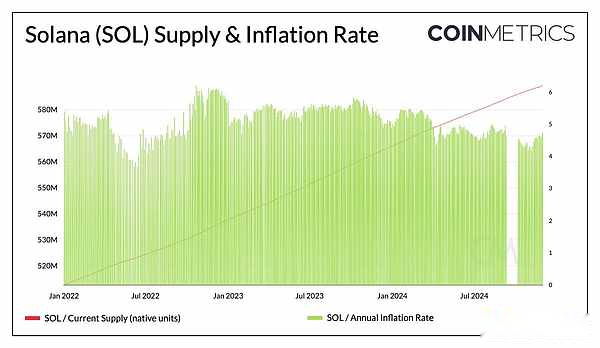
Source: Coin Metrics Network Data Pro
Solana’s nominal staking APY is currently 11.5%, while the actual (inflation-adjusted) APY is 12.5%.These yields have recently risen due to a surge in priority fees as Solana network activity increases in November.As shown in the figure below, the principal has a low yield (currently around 6.7), receiving only rewards from the new issuance, while the validators benefit from issuance, fees, commissions charged to the principal, and their own pledged SOL.This structure highlights the additional incentives for running validators, which lead to higher operating costs and benefits validators with the largest stake.
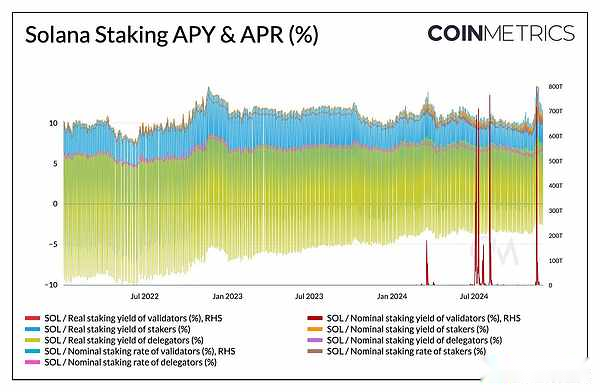
Source: Coin Metrics Network Data Pro
in conclusion
The staking mechanisms of Ethereum and Solana reflect their different design concepts.Ethereum’s modular architecture separates execution and consensus, while Solana’s delegated proof of stake (DPoS) model integrates these capabilities with high-performance infrastructure.This results in a small number of validators for Solana but a high stake rate, which is due to the low entry threshold for the principal.As Ethereum and Solana networks mature, their staking ecosystems and economic models will continue to evolve, shaping network usage, issuance, and staking proceeds to meet the growing needs of their ecosystems.

